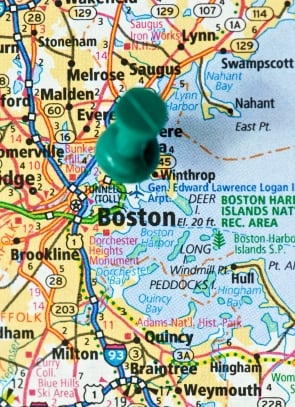Negative equity in homes across the United States is holding back the housing market and limiting real estate inventory, the Zillow Group reported March 9, 2016, but data show the percentage of homes in the Boston area underwater was only about half the national average.
 Six million U.S. homeowners owed more on their mortgage than their homes were worth in the fourth quarter of 2015, down 16 million from the peak in the first quarter of 2012. Negative equity natiowide declined 0.3 percentage points in the third quarter to 13.1 percent. The percentage of homeowners in the Boston area underwater remained at 7.1 percent from the third to the fourth quarter of 2015, but declined 27.6 percent from 9.8 percent in Q4 2014.
Six million U.S. homeowners owed more on their mortgage than their homes were worth in the fourth quarter of 2015, down 16 million from the peak in the first quarter of 2012. Negative equity natiowide declined 0.3 percentage points in the third quarter to 13.1 percent. The percentage of homeowners in the Boston area underwater remained at 7.1 percent from the third to the fourth quarter of 2015, but declined 27.6 percent from 9.8 percent in Q4 2014.
"Over time, negative equity can act as an anchor on a housing market, preventing underwater homeowners from listing their homes and reentering the market," the Zillow Group stated in its report. "It is more prevalent in less expensive areas that are affordable to first-time buyers. Without these homes available, many potential buyers are sidelined and unable to take advantage of mortgage rates that remain near historic lows."
Las Vegas, one of the hardest hit areas during the housing crash, still had the highest rate of negative equity in the fourth quarter at 20.9 percent, followed closely by the Chicago area, which 20.5 percent of its homeowners upside down on their mortgages. In the Greater San Jose area, only 2.8 percent of mortgaged homeowners were underwater. Overall, Zillow Group's report covered more than 870 metropolitan areas, 2,400 counties, and 23,000 ZIP codes across the U.S.
Negative equity is probable not a significant reason for the scarce inventory in the Greater Boston area. One factor that has limited inventory, according to many listing agents, is that many homeowners who want to sell their property are afraid that their home will sell quickly in the Boston area's strong real estate market, and they will not be able to find a new home in this low inventory environment.
|
Metropolitan Area |
2015 Q4 Negative Equity Rate |
2015 Q3 Negative Equity Rate |
2014 Q4 Negative Equity Rate |
2015 Q4 |
|
United States |
13.1% |
13.4% |
16.9% |
13.0% |
|
New York/Northern New Jersey |
11.4% |
11.5% |
13.1% |
10.6% |
|
Los Angeles-Long Beach-Anaheim, CA |
6.9% |
7.1% |
8.6% |
8.8% |
|
Chicago, IL |
20.5% |
20.6% |
25.1% |
16.6% |
|
Dallas-Fort Worth, TX |
5.8% |
5.8% |
8.6% |
13.3% |
|
Philadelphia, PA |
15.0% |
15.5% |
19.1% |
11.7% |
|
Houston, TX |
6.6% |
6.2% |
7.5% |
14.8% |
|
Washington, DC |
15.3% |
15.7% |
18.2% |
12.2% |
|
Miami-Fort Lauderdale, FL |
13.7% |
14.7% |
19.0% |
14.0% |
|
Atlanta, GA |
17.6% |
18.6% |
26.1% |
14.7% |
|
Boston, MA |
7.1% |
7.1% |
9.8% |
11.6% |
|
San Francisco, CA |
4.4% |
4.7% |
6.6% |
7.1% |
|
Detroit, MI |
16.1% |
16.6% |
21.3% |
17.3% |
|
Riverside, CA |
13.5% |
14.3% |
17.0% |
10.2% |
|
Phoenix, AZ |
15.2% |
16.4% |
20.6% |
13.6% |
|
Seattle, WA |
9.5% |
10.2% |
15.6% |
12.4% |
|
Minneapolis-St Paul, MN |
10.5% |
11.7% |
15.5% |
10.4% |
|
San Diego, CA |
7.9% |
8.1% |
8.9% |
8.6% |
|
St. Louis, MO |
17.0% |
17.6% |
22.8% |
12.6% |
|
Tampa, FL |
14.7% |
15.7% |
21.2% |
11.6% |
|
Baltimore, MD |
17.4% |
16.9% |
20.3% |
12.9% |
|
Denver, CO |
5.5% |
5.5% |
7.7% |
11.6% |
|
Pittsburgh, PA |
9.6% |
9.8% |
12.1% |
12.7% |
|
Portland, OR |
5.6% |
6.2% |
10.9% |
10.0% |
|
Charlotte, NC |
10.7% |
11.0% |
16.3% |
16.9% |
|
Sacramento, CA |
10.4% |
11.6% |
14.8% |
10.5% |
|
San Antonio, TX |
11.0% |
10.7% |
12.3% |
17.4% |
|
Orlando, FL |
15.4% |
16.1% |
20.9% |
11.2% |
|
Cincinnati, OH |
13.7% |
14.5% |
19.2% |
13.4% |
|
Cleveland, OH |
17.1% |
16.8% |
21.4% |
15.0% |
|
Kansas City, MO |
16.4% |
16.6% |
20.9% |
12.5% |
|
Las Vegas, NV |
20.9% |
22.1% |
26.4% |
13.4% |
|
Columbus, OH |
11.7% |
12.9% |
17.6% |
17.2% |
|
Indianapolis, IN |
14.6% |
15.5% |
18.3% |
14.0% |
|
San Jose, CA |
2.8% |
3.0% |
4.0% |
5.6% |
|
Austin, TX |
7.1% |
6.8% |
7.9% |
10.1% |






